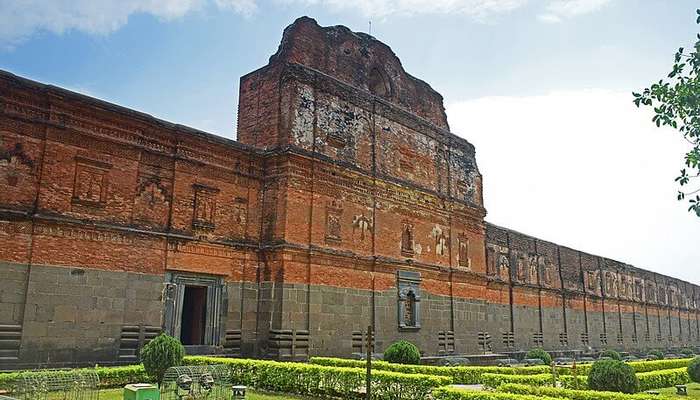




The Adina Mosque is a former mosque in Malda District, West Bengal, India. It was the largest such structure in the Indian subcontinent and was built during the Bengal Sultanate as a royal mosque by Sikandar Shah, who is also buried inside. The mosque is situated in Pandua, a former royal capital. The vast architecture is associated with the hypostyle of the Umayyad Mosque, which was used during the introduction of Islam in new areas. The early Bengal Sultanate harbored imperial ambitions after having defeated the Delhi Sultanate twice in 1353 and 1359. The Adina Mosque was commissioned in 1373. The mosque was built during the reign of Sikandar Shah, the second Sultan of the Ilyas Shahi dynasty of the Bengal Sultanate. The mosque was designed to display the kingdom's imperial ambitions after its two victories against the Delhi Sultanate in the 14th century. According to Encyclopedia Iranica, the mosque's construction material included stone from Bengali temples.[6] A few parts of the mosque's exterior wall have carvings like elephants and dancing figures. Historians have considered whether the builders used stone from pre-Islamic structures or whether the mosque was built on the site of a pre-existing ruin. Inscriptions on the mosque proclaimed Sikandar Shah as "the exalted Sultan" and the "Caliph of the faithful".[8] The Sultan was buried in a tomb chamber attached to the wall facing the direction of Mecca. The mosque was located in the historic city of Pandua, the former capital of the Bengal Sultanate. Pandua was a thriving and cosmopolitan trading center during the period of the sultanate. According to Chinese envoy Ma Huan accounts, Pandua developed from a small hamlet into a capital city with a military garrison and then a commercial, manufacturing, and trade center. Its population included royalty, indigenous people, and foreigners from across Eurasia who settled or were part of a floating population. It was a walled city with well-arranged streets and bazaars. The marketplaces sold any kind of goods, including six varieties of muslin and four types of wine. The markets included eateries, drinking houses, and bathing areas. The Sultan's residence was a white mansion. Alcohol was not served in the royal court. Another remnant of the former royal capital that still stands is the Eklakhi Mausoleum. The main structure of the royal palace, with its high steps, nine walls, and three gates, no longer exists. Remnants of the palace, including floral carvings, can be seen in Pandora's raised mounds. The mixture of seemingly Buddhist, Hindu, and Islamic decorative characteristics of the Adina Mosque has been questioned by many people. Wondering if this building is considered Islamic architecture or not, but with careful study, it has become clear that this building was put together using Islamic traditions used in many other Islamic architectures.